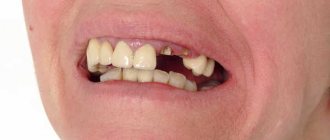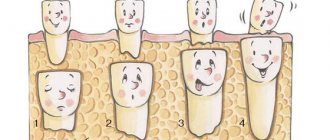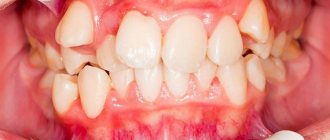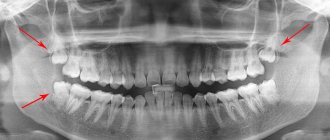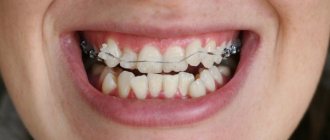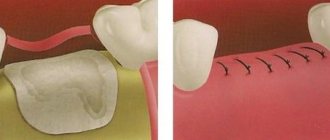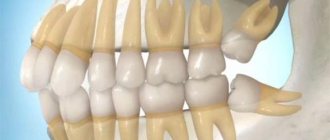Probably, almost every adult, having heard the expression “wisdom teeth,” remembers how much trouble he had to endure while these harmful “eights” tried to take their place in the dentition. Indeed, the situation when the latest teeth come out on time and without problems is very rare. Most often, this process is accompanied by pain, inflammation and problems with neighboring teeth.
Most dentists are inclined to believe that it is better to remove wisdom teeth, which cause so many difficulties. However, there are situations when it is more advisable to leave them and cure them.
What are wisdom teeth
These are the latest teeth - they appear from about 16 to 27 years. They are located at the very end of the dentition and are also called “eights” or “third molars.” There are 4 of them in total - one at the top and one at the bottom on each side.
They belong to the group of chewing teeth and in the modern world are considered more of a rudiment (an obsolete and non-functional element in the body) inherited from our ancestors. Previously, a person ate tougher and more fibrous food - rough meat and roots, and for this he needed additional teeth, which came out a little later than the rest. Now we have learned to make food soft, and our teeth no longer have to work as hard.
Is it necessary to treat complications of caries in promising wisdom teeth?
If you do not treat a tooth in time at the stage of carious destruction, then caries complications develop in the future - pulpitis, and then periodontitis. Will treatment of wisdom tooth canals be promising in such cases?
Let's start, perhaps, with pulpitis, as one of the most common diagnoses encountered at a dentist's appointment.
On a note
Pulpitis is an inflammation of the neurovascular bundle (“nerve”) inside the tooth, when this tissue, despite the onset of the inflammatory process, is still, at the very least, alive.
If we were not talking about a wisdom tooth, then any dentist-therapist would confidently say that there is no need to remove the tooth, it is enough to treat the canals. However, a wisdom tooth, unlike others, has an unpredictable number of canals, its roots are often curved, and access for comfortable and high-quality treatment is often difficult (especially when treating the upper eights). In a regular public clinic, it is not always possible to treat such a tooth efficiently, and complications may arise in the future.
At the same time, in business-class dental clinics, high-quality endodontic treatment is possible for pulpitis of almost any, even the most unusual wisdom tooth structure - with control of the processes using an image, using a dental microscope, ultrasound equipment, an apex locator and other auxiliary devices. However, the price for this service will be considerable.
On a note
There is an opinion that there are no “impassable” dental canals - but there is a lack of good specialists and the necessary equipment. That is, if the doctor hints at removing the figure eight and says that a wisdom tooth with pulpitis cannot be cured because it has curved or narrow canals, then we can only state that either the clinic does not have the appropriate equipment, or the doctor is not experienced enough .
If you have a strong desire to save your wisdom tooth from removal, then it is best to consult 2-3 doctors. If 2-3 doctors tell you to remove your wisdom tooth, and the sooner the better, then you should definitely do it.
When the inflammatory process in the pulp chamber goes far, the pulp dies, and we are already talking about the diagnosis of “periodontitis”. In this case, the doctor considers the advisability of preserving the tooth from the point of view of the risk to the patient’s health - depending on the form and stage of the process, canal treatment can be started in acute forms and in chronic fibrous periodontitis.
If we are talking about granulomas, cystogranulomas, cysts, then most often the wisdom tooth is removed “out of harm’s way ,” although sometimes tooth-preserving techniques can be chosen according to indications. Here it is up to the doctor to decide and take responsibility.
The photo below shows an extracted tooth with cysts on the roots:
On a note
Periodontitis and periodontitis are different. In acute forms (especially in the serous stage), as well as in chronic fibrous and granulating periodontitis, the possibility of preserving a wisdom tooth is significantly higher than in granulomatous periodontitis. In general, the words “granuloma”, “cystogranuloma” and “cyst” should warn you that the treatment may not be entirely successful, or the doctor will immediately suggest removing the wisdom tooth, and this will almost always be a justified decision.
What's wrong with them
Due to insufficient load and the gradual change in the size of the jaw during the process of evolution, not everyone today has wisdom teeth, and for those who have had the “lucky” ticket in the form of having them, they are rather an inconvenience. Since they are the last in the row, often there is simply no room left for them, and they can be located horizontally, at an angle, can grow into the gums or put pressure on the neighboring “sevens”.
For the same reason - their remote location - it is very difficult to reach them with a brush and a professional cleaning device. Food debris and plaque accumulate on them, which leads to the formation of caries and gum inflammation.
Treating them is also not easy - the roots of wisdom teeth are long and often curved, and if, for example, the carious process goes deep into the tooth, then getting to the source of inflammation will be problematic.
Well, among other things, the “eights” may simply not cut through to the end. Sometimes they remain in the gum for years, periodically causing it to fester and swell.
So, do these wayward teeth really bring so much suffering and problems, and we definitely need to get rid of them, and best of all, before they erupt?
Is it worth treating a wisdom tooth if it is affected by caries, or is it better to remove it immediately?
As a rule, having independently discovered caries on their teeth, patients come to dental therapists who directly treat teeth (that is, provide therapy).
Let's see how a dentist-therapist makes a decision about whether the eighth tooth with caries can be treated, or whether one should think about removing it by referring it to a dental surgeon.
Example No. 1: there were no problems with the eruption of a wisdom tooth, and it fell into place smoothly, without injuring the oral mucosa, however, pockets of caries appeared on its surface (chewing, contact, etc.) over time. In this case, there is no need to remove the wisdom tooth, but it is advisable to treat it, and as early as possible, so that the carious process does not deepen to the pulp chamber (to the “nerve”).
However, even if the tooth pulp is affected and we are no longer talking about caries, but about pulpitis, even in this case there is no need to rush to remove the wisdom tooth, you just need to treat the canals and install a filling. The tooth will be “dead”, but it can last for a very, very long time.
The photo below shows an example of significant carious decay of a wisdom tooth:
Now let's look at situations where it is not always advisable to treat a wisdom tooth with caries, and sometimes it is better to remove it as soon as possible.
Example No. 2: significant destruction of a wisdom tooth due to incomplete eruption. In other words, only individual cusps of the wisdom tooth appear above the gum, and the rest of it is under the gum, but serious carious destruction is already observed.
There is no point in waiting until the entire wisdom tooth is on the surface for its full treatment, or, moreover, enduring periodic pain, fever and swelling when it is difficult to erupt; this is a vicious practice. Of course, this does not apply to superficial caries, or even average caries with relative comfort (no symptoms of pericoronitis). However, here too it is important to monitor the situation so as not to miss the destruction of the tooth to such an extent that it will still have to be removed, but against the background of serious complications (periostitis, osteomyelitis, abscess, phlegmon).
It is also useful to read: Tooth extraction: how to prepare for the procedure and its main stages
Example No. 3: incorrect position of an erupted wisdom tooth in the jaw in the presence of significant carious destruction (including a position that complicates the hygiene of the 7th tooth). When a wisdom tooth has a significant deviation from its normal position in the jaw, it can be difficult to ensure adequate hygiene, as a result of which caries progresses quite quickly, and the seven may also be involved in the process. In addition, malocclusion in general often occurs.
Be that as it may, in practice, each situation is individual, and the doctor makes the decision whether to treat or remove a wisdom tooth taking into account the specifics of a particular clinical case.
This is interesting
Even if you have made an appointment with a dental surgeon to have your wisdom tooth removed, it is not a fact that he will remove it for you. The fact is that dental surgeons are engaged not only in removing teeth, as is popularly believed, but also in saving them by performing tooth-preserving operations (and if they are removed, then only if there are clear indications for this).
If we are not talking about some indifferent doctor in a run-down clinic, then it is a dental surgeon who will help you determine for sure whether you need to remove your wisdom tooth right now or you can try to save it.
When wisdom teeth definitely do not need to be removed
No not always. There are several conditions under which the “eight” should be left in place:
- There is enough space in the dentition, the tooth came out as it should, and does not bother you in any way.
- The tooth has an antagonist tooth - its pair at the top or bottom, with which it closes when chewing and closing the mouth.
- You will have a denture installed, and the tooth can serve as a support for it.
In such cases, it is better not to touch the wisdom tooth, clean it thoroughly and, if necessary, treat it in a timely manner.
delete
Remove the target ten meters away. | Using antennas, you can remove transmitters at a distance of 3–5 km from the base station.
Remove a splinter from a finger. | Remove weeds. | Remove harmful impurities from water. | Remove stains from fabric, rust from metal. | This powder will make your things dazzling white, removing even stubborn gray plaque. | The rose hips are cleaned of stalks and sepals, hairs and grains are removed and washed well.
Moles can be removed only after consulting an oncologist. |
Apparently you will have to remove this tooth.
When should the figure eight be removed?
However, there are many more situations where wisdom teeth interfere with life. Doctors recommend that at the first difficulty with treatment and care, seek advice and possible removal. In particular, the following cases will be direct indications for this:
- Lack of space. The tooth will move the neighboring ones, which will ultimately lead to crowding and malocclusion, and braces will have to be installed.
- Caries. The complex location and structure significantly complicate the treatment process.
- Wrong direction of growth. “Eight”, relatively speaking, can grow in any direction and damage the tissue around it, which leads to chronic injury to the mucosa.
- Absence of an antagonist tooth. Without a pair at the top or bottom, the tooth can be deformed, destroyed, injure the gum it rests on, and cause serious discomfort.
- Development of pericoronitis. This is an inflammatory process that occurs when a tooth cannot break through the gum and it becomes inflamed, gradually spreading the infection throughout the body.
In these situations, you need to act quickly and not be afraid to get rid of the problem. There is no point in treating, moving the tooth, cutting the gum, etc. It is better to just remove it.
Indications for figure eight removal
These are, first of all, the following circumstances:
- Inflammation of the gums, accompanied by pericoronitis. Pericoronitis leads to swelling of the hood (the part of the gum above the molar) and the gum itself. The cheek may also be involved in the inflammatory process. Cavities can develop under the hood.
- If gum excision does not help or the tooth is severely damaged, it is removed.
- If wisdom tooth caries - treat or remove? Therapeutic measures are ineffective or impossible. Treatment is carried out if the tooth is positioned correctly in the row. Otherwise there is no point in it.
- Pulpitis has developed, and there is no point or possibility to treat it. Caries leads to the fact that through the cavity, infections penetrate deep into the dentin. The pulp becomes inflamed and acute pain occurs. In this case, the inflamed pulp leads to the fact that a person experiences pain when the temperature of the food he eats and when he eats acid-containing foods. Your temperature may rise. If the tooth is positioned correctly, treatment is possible. If done incorrectly, treatment turns into a waste of time and money.
- Inflammation of the root and tissues surrounding it has developed - periodontitis. It causes sharp pain in the dental area, it is impossible to touch the tooth, and the pain intensifies. The tooth is movable. Often accompanied by suppuration. In such conditions, tooth extraction is advisable.
- If the wisdom tooth is positioned incorrectly and causes deformation of the entire row.
- A decision was made to correct the bite.
- The tooth took a horizontal position.
- Inflammation of the trigeminal nerve. It is difficult to confuse it with something else. The main symptoms are pain attacks in the facial area, muscles twitch. Attacks of pain can be triggered by any physical activity, even minor ones. Once the wisdom tooth is removed, the symptoms all go away.
- Jaw cyst. It is the slow growth of the figure eight that is the main reason for the formation of a cyst. A cyst may form and not grow. Then there will be no pain, there will be no symptoms. As the cyst grows, pain appears. The cyst is dangerous because fluid accumulates in it, which aggressively acts on the walls of the tooth. And if an infection penetrates into the cavity of the neoplasm, the tooth begins to fester. This is a well-known disease - flux. The tooth is removed without a doubt.
Should wisdom teeth be treated or removed for pregnant women?
How to remove a wisdom tooth
To make sure it is necessary to get rid of the tooth, the doctor will take an X-ray. In addition, he will ask you in detail about the problem and find out the possible presence of allergies to drugs. They will be needed because tooth extraction is a minor operation and is performed under local anesthetic or general anesthesia.
If the tooth has managed to erupt and emerge from the gums, the procedure will take a little time and recovery after it will be quite quick. If the tooth is impacted (located inside the gum), then it will require dissection and, possibly, extraction of the tooth in parts. It is not difficult, not dangerous and, most importantly, not painful.
After the end of the anesthesia, there will certainly be discomfort, but if you follow the doctor’s recommendations, healing will take place quickly and without problems. As a rule, antibiotics are prescribed, and it is strongly advised to give up alcohol, smoking, sports and going to the bathhouse for a while. All this increases the risk of injury, bleeding and prolongs the rehabilitation period.
Dentists at the Denta clinic are always ready to give urgent advice on problems with wisdom teeth and advise on the preferred solution to solve them. Tooth extraction in our clinic is carried out quickly, professionally and with maximum comfort for the patient.
Step-by-step treatment of wisdom tooth caries
If the dentist gave a positive answer to the question of whether to treat wisdom teeth, it is necessary to begin treatment as early as possible, before caries reaches a more advanced stage. The treatment procedure for third molars is slightly different from the treatment of other teeth in the upper or lower jaw, since due to the special arrangement of the teeth, the doctor cannot use all available technologies.
Treatment occurs in several stages:
- After anesthesia, the dentist carefully prepares the cavity and, using a drill and hand instruments, removes all tissue affected by caries.
- To prevent infection from entering the body, he treats the oral cavity and the tooth itself with an antiseptic solution.
- The dentist places a healing or insulating pad inside the cleaned cavity.
- A seal made of photocomposite material is installed on top of the gasket. It is applied in layers, and each layer is illuminated with a special lamp until completely cured.
- After filling, the tooth is adjusted to the bite, given the correct anatomical shape, ground and polished.
Difficulties of the wisdom teeth removal process
According to Dr. Repin, the complexity of such operations lies in several reasons. For example, if the operation is performed on the upper jaw, then during removal you can get a real hole in the maxillary sinus. Getting food into this area will not lead to anything good. However, this is not the worst thing.
“There is another nuance in the upper jaw - we can get a hole, but one wrong movement of the surgeon’s instrument can push the tooth into the sinus, and this is already a colossal problem,” he said. “In such cases, patients undergo a revision of the sinus and extract the tooth using more complex methods.”
Problems with these teeth can also occur in the lower jaw. The fact is that it is in the growth zone of the eights that there are those places that react extremely acutely to any inflammatory processes. Therefore, quite often after the removal of the last molars, patients experience abscesses and phlegmons. These inflammatory processes are treated in a hospital setting, and patients often have to cut the skin to do this:
“There are still complications. For example, when the figure eight is placed in the lower jaw so awkwardly that the jaw breaks during removal.”
In addition, patients often experience numbness after surgery. It occurs when, during removal, the root of the figure eight catches the nerve passing in the lower jaw. The feeling can be compared to anesthesia, which lasts for six months.

